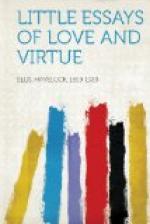This object remains not only the primary but even the sole end of marriage among the lower races of mankind generally. The erotic idea, in its deeper sense, that is to say the element of love, arose very slowly in mankind. It is found, it is true, among some lower races, and it appears that some tribes possess a word for the joy of love in a purely psychic sense. But even among European races the evolution was late. The Greek poets, except the latest, showed little recognition of love as an element of marriage. Theognis compared marriage with cattle-breeding. The Romans of the Republic took much the same view. Greeks and Romans alike regarded breeding as the one recognisable object of marriage; any other object was mere wantonness and had better, they thought, be carried on outside marriage. Religion, which preserves so many ancient and primitive conceptions of life, has consecrated this conception also, and Christianity—though, as I will point out later, it has tended to enlarge the conception—at the outset only offered the choice between celibacy on the one hand and on the other marriage for the production of offspring.
Yet, from, an early period in human history, a secondary function of sexual intercourse had been slowly growing up to become one of the great objects of marriage. Among animals, it may be said, and even sometimes in man, the sexual impulse, when once aroused, makes but a short and swift circuit through the brain to reach its consummation. But as the brain and its faculties develop, powerfully aided indeed by the very difficulties of the sexual life, the impulse for sexual union has to traverse ever longer, slower, more painful paths, before it reaches—and sometimes it never reaches—its ultimate object. This means that sex gradually becomes intertwined with all the highest and subtlest human emotions and activities, with the refinements of social intercourse, with high adventure in every sphere, with art, with religion. The primitive animal instinct, having the sole end of procreation, becomes on its way to that end the inspiring stimulus to all those psychic energies which in civilisation we count most precious. This function is thus, we see, a by-product. But, as we know, even in our human factories, the by-product is sometimes more valuable than the product. That is so as regards the functional products of human evolution. The hand was produced out of the animal forelimb with the primary end of grasping the things we materially need, but as a by-product the hand has developed the function of making and playing the piano and the violin, and that secondary functional by-product of the hand we account, even as measured by the rough test of money, more precious, however less materially necessary, than its primary function. It is, however, only in rare and gifted natures that transformed sexual energy becomes of supreme value for its own sake without ever attaining the normal physical outlet. For the most part the by-product accompanies the product, throughout, thus adding a secondary, yet peculiarly sacred and specially human, object of marriage to its primary animal object. This may be termed the spiritual object of marriage.




